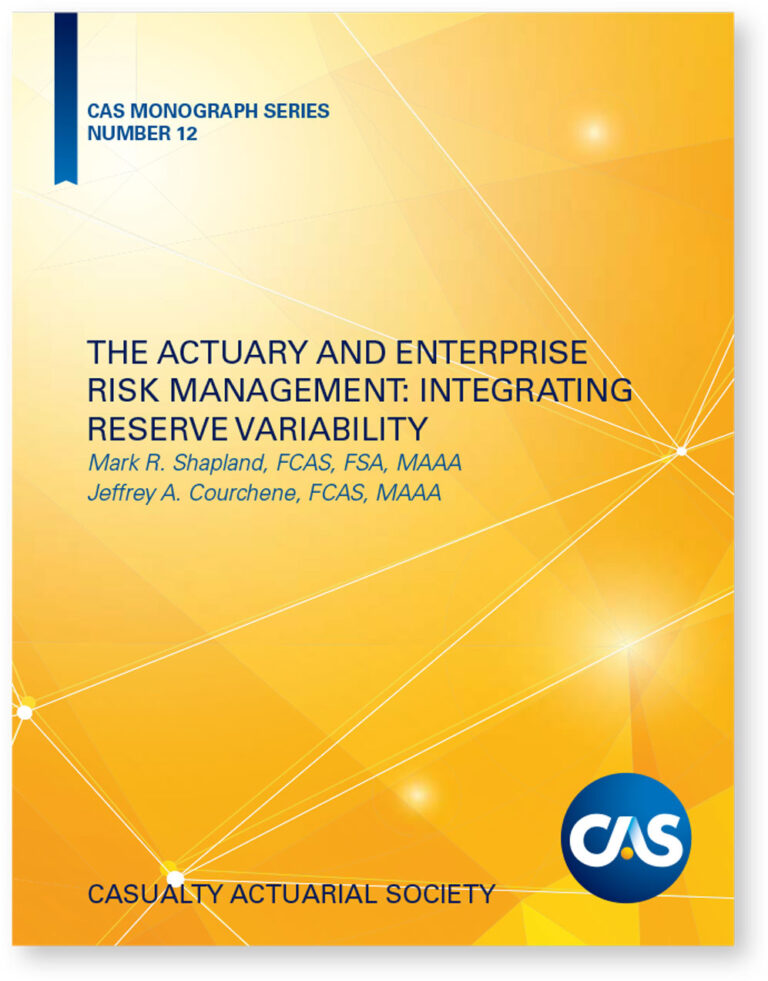
A new volume in the CAS monograph series, The Actuary and Enterprise Risk Management: Integrating Reserve Variability by CAS Fellows Mark R. Shapland and Jeffrey A. Courchene, proposes moving beyond reserve variability quantification to allow for full integration of key reserve risk metrics into the larger enterprise risk management framework.
Janice Young, ACAS, member of the Monograph Editorial Board, discusses stochastic reserving models with the authors.
Janice Young: What would you say are the key takeaways in the monograph?
Jeff Courchene: I think the three key takeaways are: (1) powerful KPIs for managing reserving risk are made available through integration of reserve risk measurement within an ERM framework; (2) KPIs providing the direction and significance of deviation from expectation are much more powerful compared to KPIs providing the direction and magnitude; and (3) proactive engagement with insurance professionals outside of the actuarial silo at the front end of a reserve analysis provides better results.
These observations are available not only in total, but based on the framework that we put together, drilling down by line of business, drilling down further by accident year and depending on your appetite for complexity could be drilled down even further.
— Jeff Courchene
I think that number two is probably the most compelling, and that has to do with when you’re looking at how well your models have performed.
Simply lining up what you expected with what happened gives you a directional indication of how well you did, either higher or lower, and gives you a magnitude indication.
If you were a lot higher or a lot lower than what happened, it becomes a question of significance, and there’s a big difference between magnitude and direction and significance and direction.
And so, it is exactly the inclusion of the stochastic reserving element that needs to be closely aligned with the processes in your deterministic methods.
That enables you to think about whether the recent performance is close to what would have been expected, meaning mean or median expectation, or whether it falls outside of what your own uncertainty analysis would have concluded as a one-in-100-year event, or anything in between. Another thing that we found is actual performance is potentially outside of the distribution that you’ve calibrated for that line of business, which has implications for the uncertainty distribution that you previously had come up with.
Janice Young: It’s wrong?
Jeff Courchene: Not necessarily wrong, but not wide enough to handle what we’ve just experienced in the past year.
And these observations are available not only in total, but based on the framework that we put together, drilling down by line of business, drilling down further by accident year and depending on your appetite for complexity could be drilled down even further.

Mark Shapland: That’s a great list. The only thing we could add to that list is the ability to help manage actuarial resources as well.
So, having these KPIs, you can quickly see where the problems are and maybe you need to reallocate some of your actuarial resources to the more problematic areas.
One of the things that wasn’t part of my thought process during the creation of the monograph, but now in retrospect I’ve added, is hoping that this might motivate U.S. actuaries to do more.
I presented the monograph about six months ago or so at the [CAS Regional Affiliate] Central States Actuarial Forum, and one of the things I said when I was introducing this is (to me this is kind of in line with Jessica Leong’s theme of the actuary of the future) that while a lot of actuaries in the U.S. are not doing this — not that I know of anyway — I think this could be something that could be part of standard actuarial practice in the U.S.
I certainly won’t be around to see it, or at least not unretired long enough to see it, but I think it’s something actuaries could do here. And I hope it does motivate people to do more and do some of the things that the Europeans are doing.
Whether that happens or not, I don’t know. It probably depends on whether the accounting standards change. As long as our accounting standards are point estimates and that’s all we need, it may not happen, but I would throw that in there, anyway.
Jeff Courchene: Yes, I think that the point about resources shouldn’t be underappreciated.
I did not include that, I had forgotten about that, but we talked about that on a number of occasions as kind of an unintentional consequence of the work that we did: that actuaries tend to build up an actuarial team and then allocate various individuals to various parts of the portfolio that the company writes.
Those individuals grow up being the workers’ comp specialist actuary out of a team of 10, dealing with the reserving issues that deal with workers’ comp, and they kind of stay in that silo. There’s value to building up experience in that silo.
But what our framework offers is an early indication of which of the methods and models have performed particularly well and particularly poorly at any point in time.
I think this [Monograph] could be something that that could be part of standard actuarial practice in the U.S.
— Mark Shapland
So, if a team has resources that have, let’s say, a technical skill set that is more advanced than that of others on their team, then an indication that there’s a problem in the methods and models could motivate the allocation of that resource on a targeted basis to exactly those parts of the business that have essentially performed differently than what was previously expected.
And so you end up as an actuary managing a department. You end up in a very powerful position to not only rely on individuals gaining experience in various lines of business, which is beneficial to the process, but also being able to target technical skills in areas where significant technical skills are needed in order to refine or to think about how the model supporting that part of the business is being run.
So, it’s kind of another dimension to the management of the team that’s unlocked.
Mark Shapland: Yes. It’s management of the enterprise risks within the firm, but also management of personnel within the actuarial function.
***













